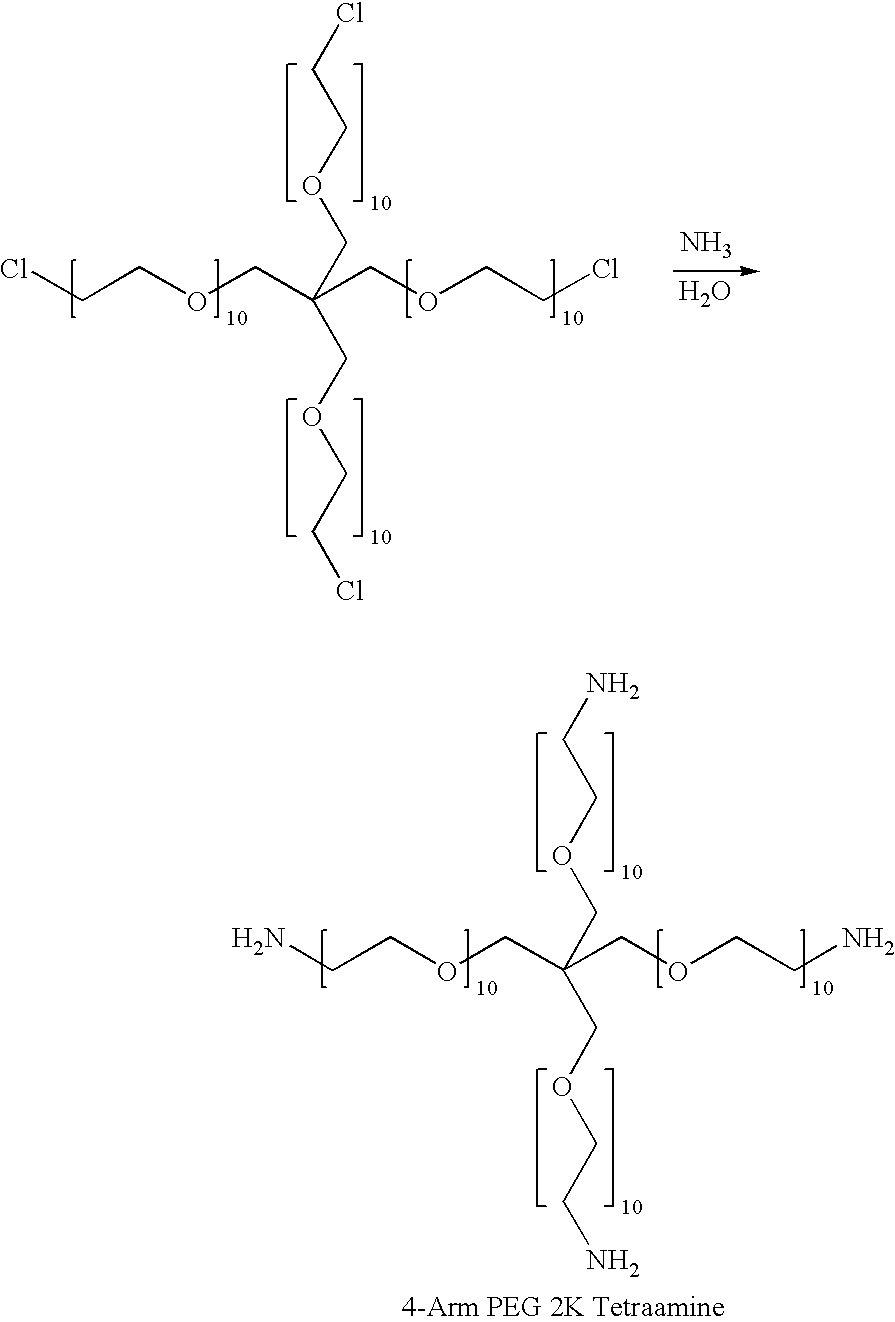Hydrogel tissue adhesive having increased degradation time
a tissue adhesive and hydrogel technology, applied in the field of medical adhesives, can solve the problems of limited internal application use of fibrin-based adhesives, slow curing of fibrin-based adhesives, and general inapplicability of conventional tissue adhesives to a wide range of adhesive applications, and achieve the effect of prolonging the degradation tim
- Summary
- Abstract
- Description
- Claims
- Application Information
AI Technical Summary
Benefits of technology
Problems solved by technology
Method used
Image
Examples
examples
[0125]The present invention is further defined in the following Examples. It should be understood that these Examples, while indicating preferred embodiments of the invention, are given by way of illustration only. From the above discussion and these Examples, one skilled in the art can ascertain the essential characteristics of this invention, and without departing from the spirit and scope thereof, can make various changes and modifications of the invention to adapt it to various uses and conditions.
[0126]A reference to “Aldrich” or a reference to “Sigma” means the said chemical or ingredient was obtained from Sigma-Aldrich, St. Louis, Mo.
Reagents
[0127]The following reagents were used in the Examples:
[0128]Poloxamer 407—block copolymer of ethylene oxide (EO) and propylene oxide (PO) with average formula (EO)101-(P0)56-(EO)101, Mn=9,840 to 14,600 (Lutrol® F 127; BASF Corp., Florham Park, N.J.);
[0129]Poloxamer 188—block copolymer of ethylene oxide (EO) and propylene oxide (PO) with ...
examples 1-4
Effect of Poloxamer 407 on In Vitro Degradation Time of Hydrogels
[0157]The effect of Poloxamer 407 block copolymer addition on the degradation time of hydrogels was studied using a base formulation of 10 wt % D60-20 oxidized dextran in aqueous solution and 15 wt % P8-10-1 multi-arm PEG amine in aqueous solution. Formulations were prepared incorporating 10, 20 or 30% Poloxamer 407 in place of water in the PEG amine solution. The degradation times were measured as described in the General Methods section. The formulations and degradation times are shown in Table 1.
TABLE 1Degradation Time of Hydrogels Containing Poloxamer 407OxidizedMulti-armDegradationDextranPEG amineAdditive to PEGTimeExampleSolutionSolutionamine Solution(hours)1D60-20P8-10-1none3Comparative10 wt %15 wt %2D60-20P8-10-1Poloxamer 4072010 wt %15 wt %10 wt %3D60-20P8-10-1Poloxamer 4076010 wt %15 wt %20 wt %4D60-20P8-10-1Poloxamer 407>12010 wt %15 wt %30 wt %
[0158]As can be seen from the results in Table 1, the addition o...
examples 5-14
Effect of Poloxamer and Poly(ethylene glycol) on In Vitro Degradation Time and Sag Distance of Hydrogels
[0159]Two types of Poloxamer block copolymers and two types of linear PEGs with alcohol end groups were evaluated as additives to oxidized dextran / multi-arm PEG amine hydrogels. The degradation times and sag distances were measured using the methods described in General Methods. The formulations, degradation and sag properties are shown in Table 2.
[0160]As can be seen from the results in Table 2, all of the additives retarded degradation compared to the controls without an additive (Examples 5 and 10, Comparative). In several cases the retardation was dramatic. The additives also reduced sag distance, which is desirable because excessive flow of material upon application of the components to a tissue site is undesirable.
TABLE 2Degradation Time and Sag Distance of Hydrogels ContainingPolyol AdditivesMulti-armAdditive toDe-SagOxidizedPEGPEGgradationDis-DextranamineamineTimetanceExam...
PUM
| Property | Measurement | Unit |
|---|---|---|
| Fraction | aaaaa | aaaaa |
| Fraction | aaaaa | aaaaa |
| Fraction | aaaaa | aaaaa |
Abstract
Description
Claims
Application Information
 Login to View More
Login to View More - R&D
- Intellectual Property
- Life Sciences
- Materials
- Tech Scout
- Unparalleled Data Quality
- Higher Quality Content
- 60% Fewer Hallucinations
Browse by: Latest US Patents, China's latest patents, Technical Efficacy Thesaurus, Application Domain, Technology Topic, Popular Technical Reports.
© 2025 PatSnap. All rights reserved.Legal|Privacy policy|Modern Slavery Act Transparency Statement|Sitemap|About US| Contact US: help@patsnap.com

